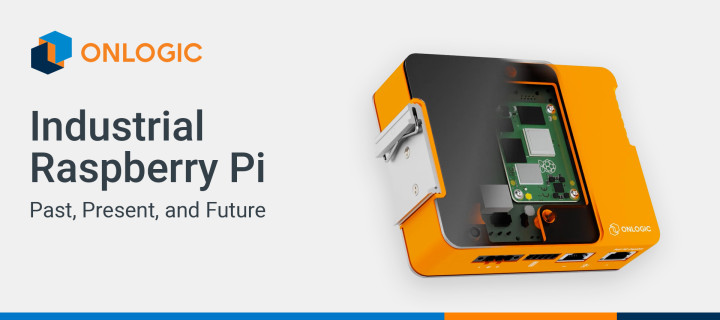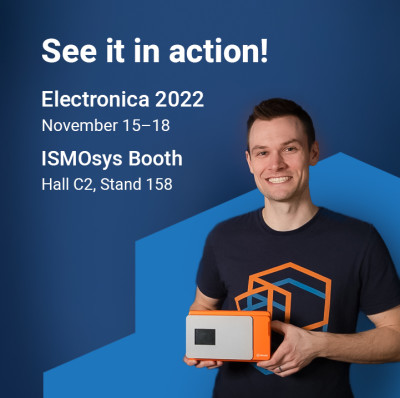Industrial Raspberry Pi: Past, Present, and Future
October 21, 2022
on
on
When Raspberry Pi launched in 2012, its goals, capabilities, and applications focused on providing individuals with the tools they needed to create innovative solutions. The first production Raspberry Pi gave makers of all ages a low-cost platform to learn the basics of coding. Part of the goal of those early devices was to democratize access to hardware and coding knowledge. In the years that followed, that mission was a success, with Raspberry Pi development boards providing the platform for countless exciting creations.
With the release of the Raspberry Pi Compute Module, a wealth of new application possibilities for this palm-sized platform have become available. Developers at all levels of technology, from makers to enterprise, are leveraging Raspberry Pi in ways never considered in the early days.

The passionate Raspberry Pi community that developed online provided a resource to share inspiration and help others with their own projects. The community quickly became a collective of like-minded builders whose exchange of ideas, code, and tutorials built on each other and inspired subsequent product releases from Raspberry Pi.
Countless examples of fascinating creations using Raspberry Pi are easy to find, but popular projects include the RetroPie emulation software to play retro video games on a Raspberry Pi, and the Magic Mirror, which embeds a Raspberry Pi into a mirror to display things like the weather forecast and email. While these projects were designed by individuals for individuals, it's not difficult to see how the same core concepts might be applied to create products for sale.
Some of these home projects made big splashes on social media, and entire publications were spawned to highlight the incredible things being built. As innovation continued, marketable solutions using Raspberry Pi were quick to follow, and commercially available products started to hit the market. Still, there remained a perception that the Raspberry Pi was an exclusively recreational or educational computing device rather than a tool for commercial, let alone industrial, applications.
The ability to prototype end solutions on an inexpensive board made the cost of entry for solution and system design much lower when compared to prototyping on traditional desktop machines or industrial systems. Smart home applications grew into smart building applications. IoT sensors for the home evolved into IoT sensors for industrial data collection.
The ultra-efficient innovation engine that the Raspberry Pi community provided allowed for ideas to be workshopped and solutions crowdsourced at a speed not commonly found in the industrial space. What's more, the explosion of the Industrial Internet of Things (IIoT) led solution providers on a search for smaller and smaller computing solutions that could be easily integrated into devices. From building automation and smart factory applications, to digital signage and PLC deployments, Raspberry Pi increasingly checked the right boxes for capabilities and customization. By 2020, according to Raspberry Pi CEO Eben Upton, more than half of Raspberry Pi end users were utilizing them for commercial and industrial applications.
“We are ready to take the wraps off something special, this time aimed at business and industrial users.”
~James Adams, COO & Hardware Lead of Pi Trading
The new platform contained the “guts” of the Raspberry Pi integrated onto a small board designed to fit into a standard DDR2 SODIMM slot. Bearing a striking resemblance to a stick of RAM, the Compute Module was intended to be integrated into PCBs (Printed Circuit Boards), commonly referred to as carrier boards.
The release of the Raspberry Pi Compute Module was arguably the tipping point for industrial Raspberry Pi powered devices. Integrating a Raspberry Pi into application specific carrier boards allowed hardware designers to expand options for form factors and create expanded I/O connectivity options to serve their specific business or industry needs.
100-pin high-density electrical interface connector.
The CM4 with its longer lifecycle components, expanded performance capabilities, and easy to integrate form factor opened the door for solutions powered by a truly industrial Raspberry Pi. However, what was missing was the ability for industrial users to identify, configure and then standardize on a pre-built platform that would give them confidence to build solutions at scale.
Today there are a range of these industrial Raspberry Pi devices being offered by hardware manufacturers and solution providers. They vary a great deal in intended application, capabilities and quality, but they share a common goal of finally bringing Raspberry Pi to the industrial space in a way that's scalable, reliable, and cost effective.
If you'd like to see what an industrial Raspberry Pi solution looks like for yourself, you can get hands-on with the Factor 200 Series at Electronica 2022 in Munich, Germany, November 15–18. OnLogic will be featured in the ISMOsys booth, located in Hall C2, Stand 158.

With the release of the Raspberry Pi Compute Module, a wealth of new application possibilities for this palm-sized platform have become available. Developers at all levels of technology, from makers to enterprise, are leveraging Raspberry Pi in ways never considered in the early days.

Maker Roots
Early Raspberry Pi single-board computers inspired countless makers in garages, basements, and classrooms across the world to look for new ways to actuate, and automate, their ideas.The passionate Raspberry Pi community that developed online provided a resource to share inspiration and help others with their own projects. The community quickly became a collective of like-minded builders whose exchange of ideas, code, and tutorials built on each other and inspired subsequent product releases from Raspberry Pi.
Countless examples of fascinating creations using Raspberry Pi are easy to find, but popular projects include the RetroPie emulation software to play retro video games on a Raspberry Pi, and the Magic Mirror, which embeds a Raspberry Pi into a mirror to display things like the weather forecast and email. While these projects were designed by individuals for individuals, it's not difficult to see how the same core concepts might be applied to create products for sale.
Some of these home projects made big splashes on social media, and entire publications were spawned to highlight the incredible things being built. As innovation continued, marketable solutions using Raspberry Pi were quick to follow, and commercially available products started to hit the market. Still, there remained a perception that the Raspberry Pi was an exclusively recreational or educational computing device rather than a tool for commercial, let alone industrial, applications.
Rapid Prototyping on Pi Provides a Bridge to Industry
The early concepts for an industrial Raspberry Pi solution evolved from the makers and students who were utilizing the Pi SOC. Experiencing the ease and speed with which they could prototype and launch automation, control, and IoT projects, it only made sense for product developers and design engineers to begin exploring ways to utilize these tools for their professional pursuits.The ability to prototype end solutions on an inexpensive board made the cost of entry for solution and system design much lower when compared to prototyping on traditional desktop machines or industrial systems. Smart home applications grew into smart building applications. IoT sensors for the home evolved into IoT sensors for industrial data collection.
The ultra-efficient innovation engine that the Raspberry Pi community provided allowed for ideas to be workshopped and solutions crowdsourced at a speed not commonly found in the industrial space. What's more, the explosion of the Industrial Internet of Things (IIoT) led solution providers on a search for smaller and smaller computing solutions that could be easily integrated into devices. From building automation and smart factory applications, to digital signage and PLC deployments, Raspberry Pi increasingly checked the right boxes for capabilities and customization. By 2020, according to Raspberry Pi CEO Eben Upton, more than half of Raspberry Pi end users were utilizing them for commercial and industrial applications.
The Raspberry Pi Compute Module
On April 7, 2014, James Adams, COO & Hardware Lead of Pi Trading announced the first Raspberry Pi Compute Module (CM) via their blog.“We are ready to take the wraps off something special, this time aimed at business and industrial users.”
~James Adams, COO & Hardware Lead of Pi Trading
The new platform contained the “guts” of the Raspberry Pi integrated onto a small board designed to fit into a standard DDR2 SODIMM slot. Bearing a striking resemblance to a stick of RAM, the Compute Module was intended to be integrated into PCBs (Printed Circuit Boards), commonly referred to as carrier boards.
The release of the Raspberry Pi Compute Module was arguably the tipping point for industrial Raspberry Pi powered devices. Integrating a Raspberry Pi into application specific carrier boards allowed hardware designers to expand options for form factors and create expanded I/O connectivity options to serve their specific business or industry needs.
Industrial Raspberry Pi Arrives, and Thrives
Flash forward to 2020 when Raspberry Pi released the fourth generation of their Compute Module. The CM4 offers the impressive capability gains of the Raspberry Pi 4, including a Broadcom BCM2711 quad-core Cortex A72 (ARM v8) 64-bit SoC @ 1.5GHz processor, OpenGL ES 3.0 graphics, and expanded memory options. Designed for embedded applications, the form factor changed from the initial DDR2 SODIMM connector to a 2 x100-pin high-density electrical interface connector.
The CM4 with its longer lifecycle components, expanded performance capabilities, and easy to integrate form factor opened the door for solutions powered by a truly industrial Raspberry Pi. However, what was missing was the ability for industrial users to identify, configure and then standardize on a pre-built platform that would give them confidence to build solutions at scale.
Today there are a range of these industrial Raspberry Pi devices being offered by hardware manufacturers and solution providers. They vary a great deal in intended application, capabilities and quality, but they share a common goal of finally bringing Raspberry Pi to the industrial space in a way that's scalable, reliable, and cost effective.
The Factor 200 Series of Industrial Raspberry Pi Computers
One example of this new generation of industrial Raspberry Pi devices in the Factor 200 Series from OnLogic. Factor 200 devices integrate an industrial carrier board for the CM4 and a custom-designed fanless industrial chassis. The Factor 202 model also adds additional digital input and output (DIO) and analog inputs, to allow for customizable device communications and signaling. The Factor 200 Series, and devices like it, are making a place for Raspberry Pi in the industrial space, and project developers looking for a scalable, ARM-based solution are taking notice.If you'd like to see what an industrial Raspberry Pi solution looks like for yourself, you can get hands-on with the Factor 200 Series at Electronica 2022 in Munich, Germany, November 15–18. OnLogic will be featured in the ISMOsys booth, located in Hall C2, Stand 158.

Read full article
Hide full article


Discussion (0 comments)